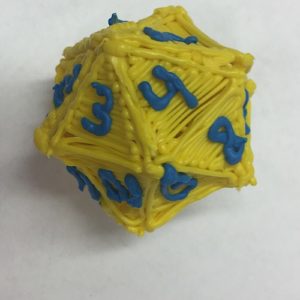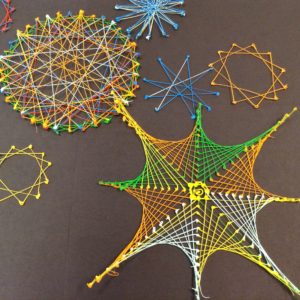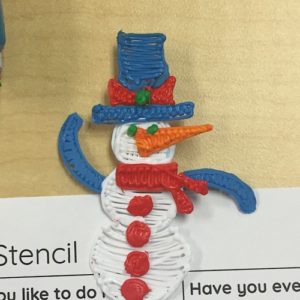MATH: Doodle-Butterflies (Symmetry)
In this activity, students will work in pairs to doodle symmetrical butterflies to be displayed as stained glass renderings mounted on windows or against fabric backdrops. This activity is simple, yet it yields exquisite results.

KnowledgeStudents havepracticed with the 3Doodler.
had practice drawing straight lines, outlines and fill with the 3Doodler.
understand the properties of symmetry.
practiced with the 3Doodler.
had practice drawing straight lines, outlines and fill with the 3Doodler.
understand the properties of symmetry.
ObjectivesStudents willbe able to recognize when butterfly wings are symmetrical.
doodle three different sizes of symmetrical butterflies.
display the properties of symmetry in their butterfly wing designs.
mount their butterflies as stained glass against a fabric or window background.
be able to recognize when butterfly wings are symmetrical.
doodle three different sizes of symmetrical butterflies.
display the properties of symmetry in their butterfly wing designs.
mount their butterflies as stained glass against a fabric or window background.
MaterialsStudents will need3Doodler (1 per pair)
Precut large, medium and small butterfly template wings (1 of each size per pair)
tissue paper (3x 4"x 6" squares in 3 different colors per pair)
chalk (1 per pair)
heavy cardstock (1 per pair)
1 printout of this Monarch Butterfly (teacher use)
optional - fabric for mounting (1 per pair)
optional - black construction paper for paper frame (1 per pair)
3Doodler (1 per pair)
Precut large, medium and small butterfly template wings (1 of each size per pair)
tissue paper (3x 4"x 6" squares in 3 different colors per pair)
chalk (1 per pair)
heavy cardstock (1 per pair)
1 printout of this Monarch Butterfly (teacher use)
optional - fabric for mounting (1 per pair)
optional - black construction paper for paper frame (1 per pair)
Lesson PlanInstructions
Step 1 - PREPARATIONPrecut 1 large, medium and small butterfly template wing for each pair of students.
Print out a picture of this Monarch Butterfly.
Step 2Whole Group: Visit the National Geographic for Kids website to explore the symmetrical wings of a monarch butterfly. Discuss the shape, lines, colors and markings on the butterfly's wings.
Step 3Fold the printed Monarch Butterfly and guide students to note how the two side match. Use the word "symmetry" and "symmetrical" to describe the properties of matching characteristics.
Step 4Ask: Does the size of the butterfly matter? Can the wings be symmetrical on a small, medium and large butterfly?
Step 5Share the goal: During this session, students will work with a partner to doodle 1-small, 1-medium, and 1-large doodle-butterfly with matching, symmetrical wings.
Step 6A) Model how to use the 3Doodler.
B) Model how to use the pre-cut wing templates and chalk to design butterfly wings on each set of tissue paper squares.
C) Show the students how to trace around the pre-cut template using chalk, so as to leave the chalk outline on the tissue paper.
D) Use chalk to make symmetrical markings on each set of butterfly's wings.
E) Doodle over the chalk butterfly outline on the tissue paper, and the symmetrical markings.
F) Flip template around to doodle the opposite side of the butterfly's wings.
Step 7*Optional: Use a pocket mirror. Hold it against one side of a set of wings. Ask whether markings on wings match.
*Teacher may model doodling wings that are NOT symmetrical to assess whether students note the differences.
Step 8Hand out materials to each pair and circle to assist and assess. Each pair should have tissue paper, 3 size wing templates, chalk, and a 3Doodler.
Step 9Help students mount on paper, fabric or windows.
Precut 1 large, medium and small butterfly template wing for each pair of students.
Print out a picture of this Monarch Butterfly.
Whole Group: Visit the National Geographic for Kids website to explore the symmetrical wings of a monarch butterfly. Discuss the shape, lines, colors and markings on the butterfly's wings.
Fold the printed Monarch Butterfly and guide students to note how the two side match. Use the word "symmetry" and "symmetrical" to describe the properties of matching characteristics.
Ask: Does the size of the butterfly matter? Can the wings be symmetrical on a small, medium and large butterfly?
Share the goal: During this session, students will work with a partner to doodle 1-small, 1-medium, and 1-large doodle-butterfly with matching, symmetrical wings.
A) Model how to use the 3Doodler.
B) Model how to use the pre-cut wing templates and chalk to design butterfly wings on each set of tissue paper squares.
C) Show the students how to trace around the pre-cut template using chalk, so as to leave the chalk outline on the tissue paper.
D) Use chalk to make symmetrical markings on each set of butterfly's wings.
E) Doodle over the chalk butterfly outline on the tissue paper, and the symmetrical markings.
F) Flip template around to doodle the opposite side of the butterfly's wings.
*Optional: Use a pocket mirror. Hold it against one side of a set of wings. Ask whether markings on wings match.
*Teacher may model doodling wings that are NOT symmetrical to assess whether students note the differences.
Hand out materials to each pair and circle to assist and assess. Each pair should have tissue paper, 3 size wing templates, chalk, and a 3Doodler.
Help students mount on paper, fabric or windows.
Wrap Up
Assessment
Possible Extensions
Vocabulary
collaboration - to work jointly with others or together especially in an intellectual endeavor.
color - the quality of an object or substance with respect to light reflected by the object, usually determined visually by measurement of hue, saturation, and brightness of the reflected light; saturation or chroma; hue.
drawing - the art or technique of representing an object or outlining a figure, plan, or sketch by means of lines.
large - of more than average size, quantity, degree, etc.; exceeding that which is common to a kind or class; big; great.
line - an infinite extent which is one-dimensional and straight.
matching - a person or thing that equals or resembles another in some respect.
medium - a middle state or condition; mean.
problem-solving - the process or act of finding a solution to a problem.
shapes - the quality of a distinct object or body in having an external surface or outline of specific form or figure.
size - the spatial dimensions, proportions, magnitude, or bulk of anything.
small - of limited size; of comparatively restricted dimensions; not big; little.
symmetry - the correspondence in size, form, and arrangement of parts on opposite sides of a plane, line, or point; regularity of form or arrangement in terms of like, reciprocal, or corresponding parts.
Educational Standards
Model with mathematics.
Students will model symmetry by designing and doodling butterfly wings.
Look for and make use of structure.
Students will distinguish defining attributes of symmetry in the wings of butterflies by examining lines, shapes, and patterns.
Decompose (break down) a larger problem into smaller sub-problems with teacher guidance or independently.
Students will break down the process of recognizing, identifying and understanding attributes of symmetry during this activity.
Use technology to seek feedback that informs and improves their practice and to demonstrate their learning in a variety of ways.
Students will use the 3Doodler to create symmetrical butterfly wings.
Create original works or responsibly repurpose or remix digital resources into new creations.
Students will use a 3Doodler to doodle symmetrical markings on their butterfly wings.
Use collaborative technologies to work with others, including peers, experts or community members, to examine issues and problems from multiple viewpoints.
Students will seek feedback from peers throughout the doodling portion of this project.


